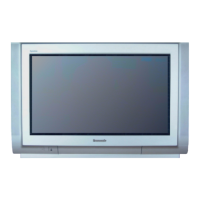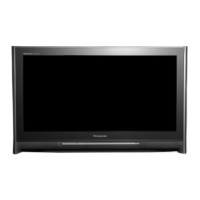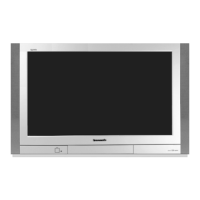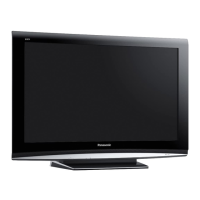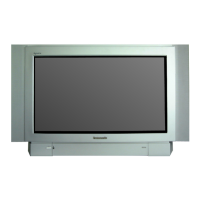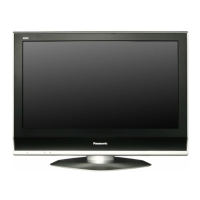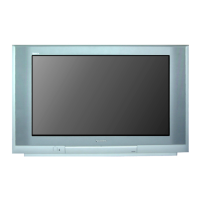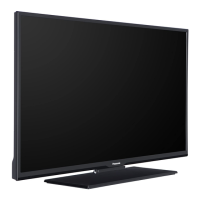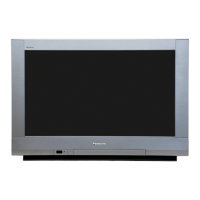Do you have a question about the Panasonic TX-32F250A and is the answer not in the manual?
Essential safety guidelines for TV operation, handling, and environment.
Instructions for connecting the external antenna to the RF input terminal for optimal picture and sound.
Steps for installing batteries in the remote control, including cautions.
Guidance on connecting the TV's power plug to the wall outlet.
How to switch the television set on from standby mode.
Connecting external devices like VCRs to AV input terminals.
How to connect a DVD player to the TV's DVD input terminals.
Connecting the TV's monitor output terminals to other audio/video equipment.
Identifies the location of buttons and terminals on the TV set.
Illustrates the navigation flow of the TV's main menu using the remote control.
Steps to switch the TV set on and off using the power switch and standby mode.
Various ways to select channels, including direct entry and up/down buttons.
Adjusting sound volume and switching between TV and AV input sources.
Using the mute button to silence sound and the recall button for system status.
Setting the off-timer, rapid tuning, and surround sound options.
Adjusting picture aspect ratio and managing favorite channels.
Restoring picture or sound settings to factory presets using the 'N' button.
Selecting between STEREO, BILINGUAL, and MONO sound modes based on broadcast.
Correcting picture tilting or color patches using the geomagnetic correction feature.
Tips for optimal placement to minimize geomagnetic interference.
Choosing picture modes like Dynamic, Standard, or Cinema for different viewing conditions.
Adjusting Contrast, Brightness, Colour, Sharpness, and NTSC-Tint for personal preference.
Adjusting colour temperature and reducing picture noise using P-NR.
Choosing the screen refresh method (Auto, 100Hz, Progressive) for optimal picture display.
Selecting sound modes like Music, News, or Cinema for enhanced audio experience.
Adjusting Volume, Equalizer, Balance, AVL, and Surround sound settings.
Fine-tuning audio frequencies for bass and treble adjustment using the equalizer.
Configuring Teletext modes, off-timer, and wake-up timer.
Adjusting flicker reduction, colour settings, blue back, VCR/GAME, favorite channels, and text language.
Setting up child lock for channels and performing geomagnetic correction for picture purity.
Adding, viewing, and cancelling favorite channels for quick access.
Overview of how to access and navigate the tuning menu options.
Choosing channel selection methods (Position, Direct) and system types (e.g., PAL, NTSC).
Using auto tuning, manual tuning, sound/colour systems, fine tuning, and skip functions.
Detailed explanation of Position Select and Direct Select for channel tuning.
A table showing channel numbers for different regions and systems.
Step-by-step guide for performing auto tuning via remote control and front panel.
Step-by-step guide for performing manual tuning via remote control and front panel.
How to select the display language for menus and Teletext.
Setting up the remote control to operate Panasonic VCRs and DVD players.
Overview of functions controllable via the remote for VCR and DVD equipment.
Explains TOP, List, FASTEXT modes, page selection, and holds.
How to switch between TV and Teletext modes and use colour-coded buttons.
Using index, full/top/bottom, reveal, and display cancel functions.
Storing favourite pages and accessing sub-coded pages for Teletext.
Diagnosing and resolving common issues like snowy pictures, no sound, interference, and coloured patches.
Details on receiving systems, broadcast channels, and tuning system.
Information on picture tube, audio output, terminals, remote control, and dimensions.
Space to record model and serial numbers for warranty and service purposes.
Essential safety guidelines for TV operation, handling, and environment.
Instructions for connecting the external antenna to the RF input terminal for optimal picture and sound.
Steps for installing batteries in the remote control, including cautions.
Guidance on connecting the TV's power plug to the wall outlet.
How to switch the television set on from standby mode.
Connecting external devices like VCRs to AV input terminals.
How to connect a DVD player to the TV's DVD input terminals.
Connecting the TV's monitor output terminals to other audio/video equipment.
Identifies the location of buttons and terminals on the TV set.
Illustrates the navigation flow of the TV's main menu using the remote control.
Steps to switch the TV set on and off using the power switch and standby mode.
Various ways to select channels, including direct entry and up/down buttons.
Adjusting sound volume and switching between TV and AV input sources.
Using the mute button to silence sound and the recall button for system status.
Setting the off-timer, rapid tuning, and surround sound options.
Adjusting picture aspect ratio and managing favorite channels.
Restoring picture or sound settings to factory presets using the 'N' button.
Selecting between STEREO, BILINGUAL, and MONO sound modes based on broadcast.
Correcting picture tilting or color patches using the geomagnetic correction feature.
Tips for optimal placement to minimize geomagnetic interference.
Choosing picture modes like Dynamic, Standard, or Cinema for different viewing conditions.
Adjusting Contrast, Brightness, Colour, Sharpness, and NTSC-Tint for personal preference.
Adjusting colour temperature and reducing picture noise using P-NR.
Choosing the screen refresh method (Auto, 100Hz, Progressive) for optimal picture display.
Selecting sound modes like Music, News, or Cinema for enhanced audio experience.
Adjusting Volume, Equalizer, Balance, AVL, and Surround sound settings.
Fine-tuning audio frequencies for bass and treble adjustment using the equalizer.
Configuring Teletext modes, off-timer, and wake-up timer.
Adjusting flicker reduction, colour settings, blue back, VCR/GAME, favorite channels, and text language.
Setting up child lock for channels and performing geomagnetic correction for picture purity.
Adding, viewing, and cancelling favorite channels for quick access.
Overview of how to access and navigate the tuning menu options.
Choosing channel selection methods (Position, Direct) and system types (e.g., PAL, NTSC).
Using auto tuning, manual tuning, sound/colour systems, fine tuning, and skip functions.
Detailed explanation of Position Select and Direct Select for channel tuning.
A table showing channel numbers for different regions and systems.
Step-by-step guide for performing auto tuning via remote control and front panel.
Step-by-step guide for performing manual tuning via remote control and front panel.
How to select the display language for menus and Teletext.
Setting up the remote control to operate Panasonic VCRs and DVD players.
Overview of functions controllable via the remote for VCR and DVD equipment.
Explains TOP, List, FASTEXT modes, page selection, and holds.
How to switch between TV and Teletext modes and use colour-coded buttons.
Using index, full/top/bottom, reveal, and display cancel functions.
Storing favourite pages and accessing sub-coded pages for Teletext.
Diagnosing and resolving common issues like snowy pictures, no sound, interference, and coloured patches.
Details on receiving systems, broadcast channels, and tuning system.
Information on picture tube, audio output, terminals, remote control, and dimensions.
Space to record model and serial numbers for warranty and service purposes.
| Display Type | LED |
|---|---|
| Smart TV | No |
| HDMI Ports | 2 |
| USB Ports | 1 |
| Sound Output | 10 W |
| Built-in Wi-Fi | No |
| Energy Efficiency Class | A |
| Screen Size | 32 inches |
| Display Resolution | 1366 x 768 |

